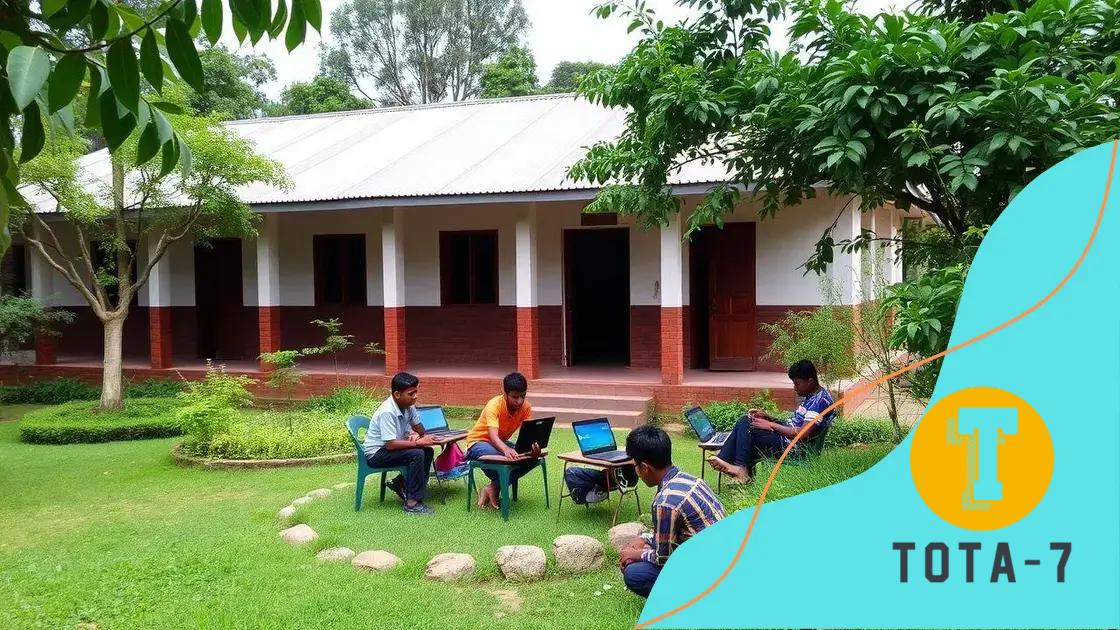Rural school broadband funding remains inadequate

Rural school broadband funding remains inadequate, significantly hindering educational opportunities, but increased investments and technological innovations offer a promising future for improving connectivity and ensuring equal access for all students.
Rural school broadband funding remains inadequate, leaving many classrooms behind. Have you ever wondered how this affects students’ learning opportunities? Let’s dive into the details and see what changes are needed.
Current state of broadband funding in rural schools
The current state of broadband funding in rural schools is a pressing issue that affects many students. A lack of proper funding often leaves these schools without the resources necessary to provide adequate internet access. This limitation hinders learning and restricts opportunities for students.
Funding Sources
Broadband funding for rural schools typically comes from various federal, state, and local sources. However, navigating these options can be challenging.
- Federal programs like E-Rate offer discounts for internet service.
- State initiatives may vary significantly in support levels.
- Local funding struggles often stem from budget constraints.
Despite these resources, many rural schools remain underfunded. The funds available often don’t meet the needs of the students or the requirements of modern learning.
Impact of Inadequate Funding
Inadequate funding results in limited access, which ultimately affects student performance. Without reliable internet, students miss out on essential digital learning tools and resources.
- Students are unable to complete online assignments efficiently.
- Teachers struggle to use technology to enhance education.
- Parental involvement and support are often diminished.
Amidst these challenges, many advocates are calling for increased attention to broadband funding in rural areas. Addressing these concerns is crucial to ensuring equality in education.
Investing in better broadband infrastructure for rural schools will provide students with equal opportunities to learn and grow, regardless of their location.
Impact of inadequate broadband on education

The impact of inadequate broadband on education is significant and multifaceted. Many students in rural areas experience barriers to learning because of limited internet access. When schools lack proper connectivity, the digital divide widens, leaving these students at a disadvantage.
Effects on Student Learning
When students do not have reliable internet, their educational opportunities shrink. They may struggle with completing assignments online or accessing valuable resources.
- Homework and projects that require internet research become difficult.
- Collaboration with peers on group assignments is often hindered.
- Access to online tutoring and educational tools is limited.
This lack of access can lead to lower academic performance and decreased motivation among students. Learning becomes frustrating without the tools that are essential in today’s digital world.
Challenges for Teachers
Teachers also face challenges when broadband is inadequate. They find it difficult to integrate technology into their lessons, which is crucial for engaging students.
- Creative teaching methods that utilize online platforms are less effective.
- Professional development opportunities are often missed due to connectivity issues.
- Communication with parents becomes challenging, limiting support for students.
a situation where students are unable to connect with the digital world can greatly affect their future. Inadequate broadband can stifle innovation and creativity in the classroom, ultimately impacting students’ readiness for college and careers.
By addressing these broadband issues, schools can begin to bridge the gap and provide all students with equal opportunities for success in education and beyond.
Challenges faced by rural schools in accessing funding
The challenges faced by rural schools in accessing funding can be numerous and complex. Many rural schools struggle to secure the financial resources necessary to improve their infrastructure, including broadband access. Various factors contribute to these challenges and often hinder progress.
Limited Awareness of Funding Opportunities
One major challenge is the limited awareness of available funding options. Many rural schools do not have dedicated staff to research or apply for grants and programs designed to support education.
- Information about funding opportunities may not reach these schools.
- Resource constraints prevent schools from dedicating time to pursue funding.
- Network connections with other schools and organizations are often lacking.
This disconnect can lead to a lack of important financial support, which can leave schools struggling to improve their technology.
Competition for Limited Resources
Another challenge is the fierce competition for limited resources. When applying for funding, rural schools often compete with urban schools that may have more visibility and connections.
- Urban schools may attract more donor attention and corporate sponsorship.
- Funding agencies often prioritize projects in densely populated areas.
- This results in rural schools being overlooked or underfunded.
This inequity can create a cycle that further disadvantages rural students. It limits their access to modern learning tools and technologies that are vital in today’s educational landscape.
Economic Constraints
Additionally, economic constraints in rural areas can impact funding for schools. Many rural communities face lower tax revenues, making it difficult to allocate adequate funds to education.
As local economies struggle, schools may experience budget cuts. These reductions can affect teacher salaries, resources, and overall educational quality. The lack of funds for broadband expansion can severely limit students’ learning opportunities.
By recognizing these challenges, policymakers can work toward creating solutions that ensure all schools, regardless of location, have equal access to necessary funding. This is essential for bridging the gap in educational equity.
Success stories from improved broadband initiatives

Success stories from improved broadband initiatives showcase the impact that proper connectivity can have on rural education. Several schools have transformed their learning environments through enhanced internet access. These stories highlight what is possible when resources are allocated effectively.
Case Study: Maplewood Rural School
Maplewood Rural School implemented a new broadband initiative with support from state funding. As a result, they expanded their online learning resources and improved student engagement.
- Students now participate in virtual field trips to museums and historical sites.
- Teachers utilize online platforms for collaborative projects, enhancing teamwork skills.
- Access to educational software has increased, allowing personalized learning.
This initiative led to improved test scores and a greater interest in learning among students.
Case Study: Pine Valley High School
Pine Valley High School witnessed dramatic changes after upgrading their broadband access. With increased speed and reliability, students could now complete assignments and participate in online discussions without interruption.
- Teachers noticed higher participation rates in class discussions.
- Students could access a wealth of information online for research projects.
- Parental engagement improved as parents could attend virtual meetings more easily.
The improved internet access not only enhanced learning but also fostered a stronger school community.
These success stories illustrate the profound influence that improved broadband can have on education. Schools that have embraced these changes demonstrate the potential for growth and innovation, emphasizing the need for continued investment in rural broadband initiatives.
Future outlook for rural school connectivity
The future outlook for rural school connectivity is becoming more promising as awareness increases about the importance of internet access in education. With new initiatives and investments, rural schools are gaining attention from both public and private sectors.
Increased Funding and Investment
As demand for reliable internet grows, funding opportunities are expanding for rural broadband projects. Numerous organizations are allocating resources specifically for educational connectivity.
- Federal programs like the E-Rate have been enhanced to support rural schools.
- Private companies are partnering with schools to offer technology solutions.
- Local government grants for broadband infrastructure are being established.
With these investments, schools can improve their technology and ultimately enhance learning for students.
Technological Innovations
Innovations in technology also play a crucial role in improving connectivity. Emerging solutions are making it easier and more cost-effective to establish broadband access in rural areas.
- Wireless technologies can provide connectivity without the need for extensive infrastructure.
- Community networks are being established to share resources among local schools.
- Satellite internet options are becoming more reliable and affordable.
Such advancements can pave the way for a more interconnected educational landscape.
As these efforts unfold, awareness of the challenges and opportunities will help shape an inclusive future for rural education. With ongoing dedication to improving connectivity, rural schools can better prepare their students for a digital world, ensuring they have the same opportunities as those in urban areas.
FAQ – Frequently Asked Questions about Rural School Broadband Funding
What are the main challenges faced by rural schools in accessing broadband funding?
Rural schools often struggle with limited awareness of funding opportunities, competition with urban schools, and economic constraints in their communities.
How can improved broadband access benefit rural students?
Better broadband access expands learning opportunities, allowing students to participate in online resources, virtual classes, and collaborative projects.
What are some success stories from schools that improved their broadband?
Many rural schools have reported higher student engagement and improved academic performance after upgrading their internet access, participating in virtual programs, and utilizing online resources.
What is the future outlook for rural school connectivity?
The future looks promising with increased funding, technological innovations, and community support aimed at enhancing broadband access for rural schools.





